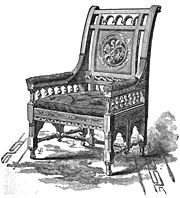
The Village Blacksmith
Encyclopedia
.jpg)
Henry Wadsworth Longfellow
Henry Wadsworth Longfellow was an American poet and educator whose works include "Paul Revere's Ride", The Song of Hiawatha, and Evangeline...
, first published in 1841. The poem describes a local blacksmith
Blacksmith
A blacksmith is a person who creates objects from wrought iron or steel by forging the metal; that is, by using tools to hammer, bend, and cut...
and his daily life. The blacksmith serves as a role model who balances his job with the role he plays with his family and community. Years after its publication, a tree mentioned in the poem was cut down and part of it was made into an armchair which was then presented to Longfellow by local schoolchildren.
Synopsis
The poem is about a local blacksmithBlacksmith
A blacksmith is a person who creates objects from wrought iron or steel by forging the metal; that is, by using tools to hammer, bend, and cut...
who is noted as being strong and for not owing anyone anything, working by the sweat of his own brow. Children coming home from school stop to stare at him as he works, impressed by the roaring bellows
Bellows
A bellows is a device for delivering pressurized air in a controlled quantity to a controlled location.Basically, a bellows is a deformable container which has an outlet nozzle. When the volume of the bellows is decreased, the air escapes through the outlet...
and burning sparks. On Sundays, the blacksmith, a single father
Single parent
Single parent is a term that is mostly used to suggest that one parent has most of the day to day responsibilities in the raising of the child or children, which would categorize them as the dominant caregiver...
after the death of his wife, takes his children to church, where his daughter sings in the choir. He goes through his life following the daily tasks assigned to him and has earned his sleep at night.
Origins

Portland, Maine
Portland is the largest city in Maine and is the county seat of Cumberland County. The 2010 city population was 66,194, growing 3 percent since the census of 2000...
, the town where the poet would be born. The actual village blacksmith in the poem, however, was a Cambridge native named Dexter Pratt, a neighbor of Longfellow's. Pratt's house is still standing at 54 Brattle Street
Dexter Pratt House
Dexter Pratt House is an historic house at 54 Brattle Street in Cambridge, Massachusetts.The house was built in 1808 and added to the National Register of Historic Places in 1973. Dexter Pratt was the village blacksmith that inspired Henry Wadsworth Longfellow's poem "The Village Blacksmith"...
in Cambridge.
Analysis
The title character of "The Village Blacksmith" is presented as an "everymanEveryman
In literature and drama, the term everyman has come to mean an ordinary individual, with whom the audience or reader is supposed to be able to identify easily, and who is often placed in extraordinary circumstances...
" and a role model: he balances his commitments to work, the community, and his family. The character is presented as an iconic tradesman who is embedded in the history of the town and its defining institutions because he is a longtime resident with deeply-rooted strength, as symbolized by the "spreading chestnut tree".
Publication and response

The Wreck of the Hesperus
"The Wreck of the Hesperus" is a dramatic poem by American poet Henry Wadsworth Longfellow, first published in Ballads and Other Poems in 1842.-Overview:...
", was instantly popular. In 1879, years after the publication of "The Village Blacksmith", the local schoolchildren in Cambridge, Massachusetts
Cambridge, Massachusetts
Cambridge is a city in Middlesex County, Massachusetts, United States, in the Greater Boston area. It was named in honor of the University of Cambridge in England, an important center of the Puritan theology embraced by the town's founders. Cambridge is home to two of the world's most prominent...
presented Longfellow with an armchair made from "the spreading chestnut
Chestnut
Chestnut , some species called chinkapin or chinquapin, is a genus of eight or nine species of deciduous trees and shrubs in the beech family Fagaceae, native to temperate regions of the Northern Hemisphere. The name also refers to the edible nuts they produce.-Species:The chestnut belongs to the...
tree" in the poem which was recently cut down. Under the cushion of the chair is a brass plate on which is inscribed, in part: "This chair made from the wood of the spreading chestnut-tree is presented as an expression of his grateful regard and veneration by the children of Cambridge". From then on, Longfellow made it a rule to always allow schoolchildren to be admitted into his study to see the chair. He also composed a poem to commemorate his gift called "From my Arm-Chair". The site on Brattle Street in Cambridge where the tree once stood is now marked with a plaque.
External links
- 1890 illustrated version at Google Book SearchGoogle Book SearchGoogle Books is a service from Google that searches the full text of books that Google has scanned, converted to text using optical character recognition, and stored in its digital database. The service was formerly known as Google Print when it was introduced at the Frankfurt Book Fair in October...

